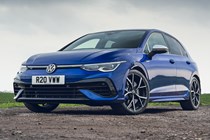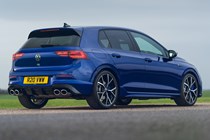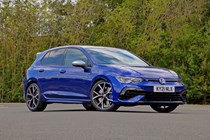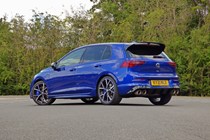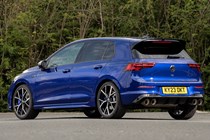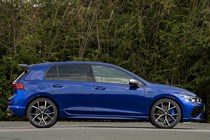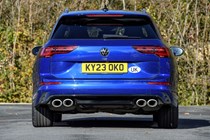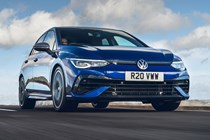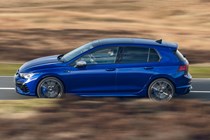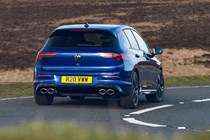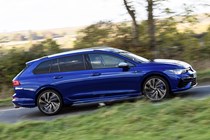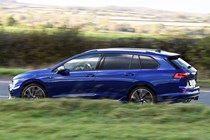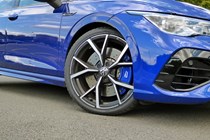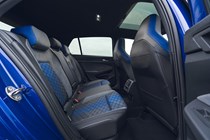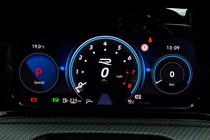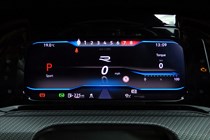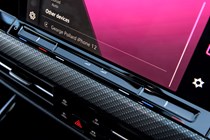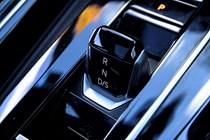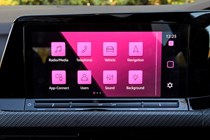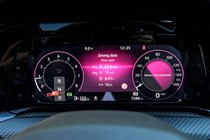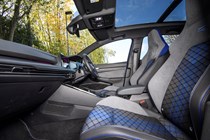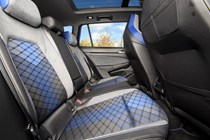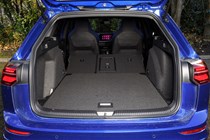
Volkswagen Golf R long-term test
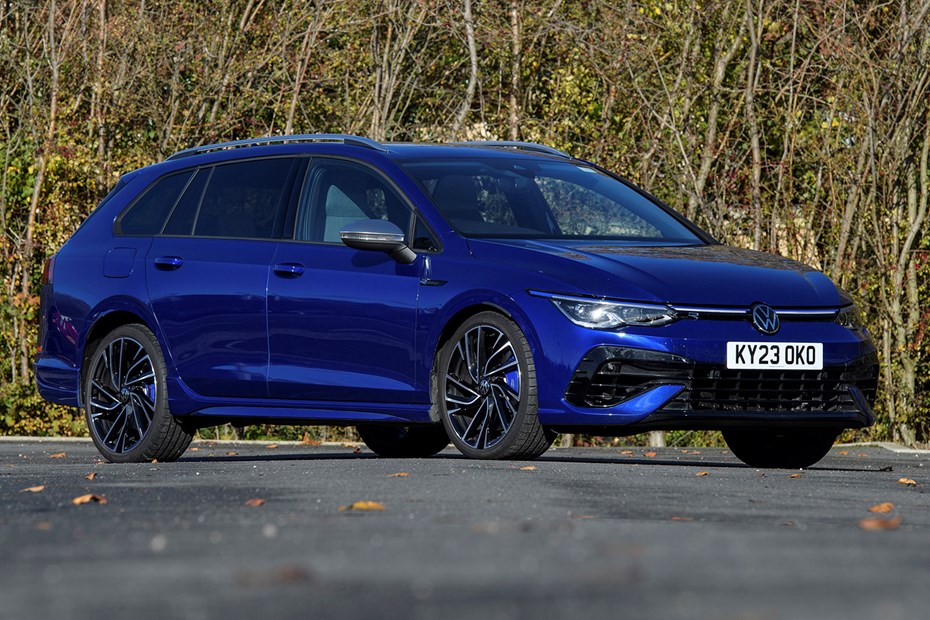
Want a high performance family car that’s also capable of exciting you when you’re driving alone? There are lots to choose from – but the Volkswaen Golf R is something else entirely because it does so discreetly. We’re running a Golf R Estate for six months to find out if it’s still the best car of its type.
Reports by Keith Adams.
Jump to:
- Cabin and controls
- Performance, handling and economy
- Comfort (back-to-back European trips)
- Running costs (motorway fuel consumption)
- Interior, tech and comfort (on a 3,000-mile road trip)
- Verdict
Update 1: Welcome
Introducing the Volkswagen Golf R Estate
Welcome to the extended long-term review of the Volkswagen Golf R Estate, one the most compelling family cars on sale right now. The R is a car that the Parkers testing team consistently enjoys spending time in, and for very good reason – it’s fast, handles beautifully, and because it’s discreetly styled, proves remarkably easy to live with.
So, you know it’s good. If you’ve arrived here via the Golf R review, you’ll know this already, and will be interested to discover what this supremely capable fast family car is like to live with on an extended basis. This is the first time we’ve run a Golf Mk8 in Estate form, despite being such a useful all-rounder.
You’ll already know that we rate the Golf Mk8 range highly, and particularly appreciate the range-topping R version, but it’s not without its frustrations, most notably its infotainment system and the extensive use of touch sensitive controls throughout the high-quality cabin.
Check out the Volkswagen Golf specs page on Parkers for the entire range – especially worth bearing in mind when it comes to pricing up your car.
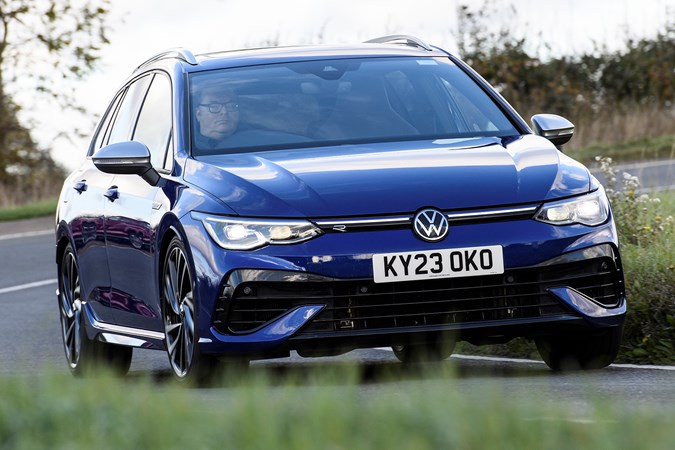
What you get with a Golf R
Despite costing more than £50,000 after options, being a performance car, the R is not the last word in luxury. You get manual adjustment for the seats, and a manually-operated tailgate for instance. But in terms of infotainment and connectivity, it’s (almost) fully featured and bang up to date. You also can’t fault the rest of the tech on offer, either.
Here are the top five features you get as standard:
- Discover Navigation system with 10.0-inch touchscreen, European navigation data, speed limit display, simultaneous pairing of two mobile devices and wireless smartphone charger.
- Three-year subscription to We Connect Plus fully connected services with ‘eCall’ calls, breakdown support and online theft alarm.
- Adaptive cruise control and lane-keeping assist
- IQ Light LED matrix headlights, LED daytime running lights and indicators, dynamic curve lighting
- Wireless Apple CarPlay/Android Auto
- Tri-zone climate control
That’s a small selection of what comes as standard, but these are highlights of a very impressive technical package. In addition, there’s £4,950 of optional extras and snazzy paint specified, which I’ll go through in the next update.
Given I now live three hours from the office and am surrounded by some of the best driving roads in Britain, fine motorway performance coupled with inspired B-road ability is essential for my sanity. So, the Golf R will really need to prove itself as the consummate all-rounder as quickly as possible.
A few family trips interspersed with some overseas business trips should soon see whether it’s up to the task or not.
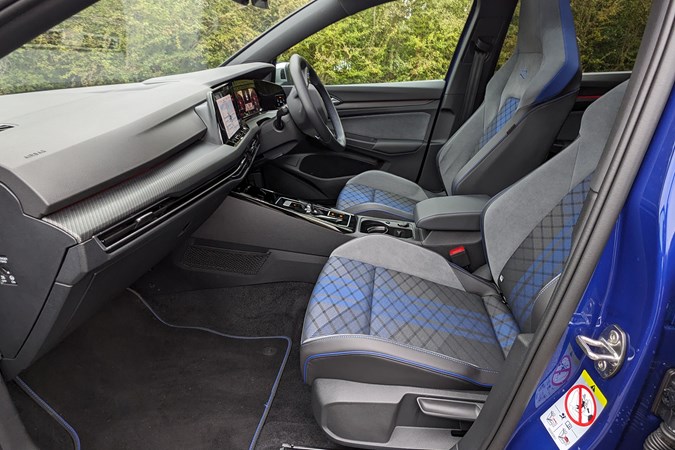
The Golf R is perfectly sized for my life – it fits happily in most parking spaces, and thanks to the added versatility of its estate rear end, also capable of carrying everything I need, including furniture for my new place. It has a tough act to follow – it comes in after my Skoda Superb, and before than, an Octavia vRS Estate, both of which were brilliant all-rounders.
Early impressions are really positive. The optional Lapiz Blue paintwork is eye-catching and beautifully applied, while the Sardegna sports seats are supportive and look great. The rest of it is discreet, classy and very understated – I originally toyed with the idea of removing the R badging, but concluded there’s actually no need.
Update 2: Cabin, equipment and options
What’s the Golf R Estate like to spend time in?
Long story short – we’re already 3,000 miles in and the Golf’s interior is growing on us. Not that there are any problems with the cabin and practicality, more that the infotainment’s definitely an acquired taste.
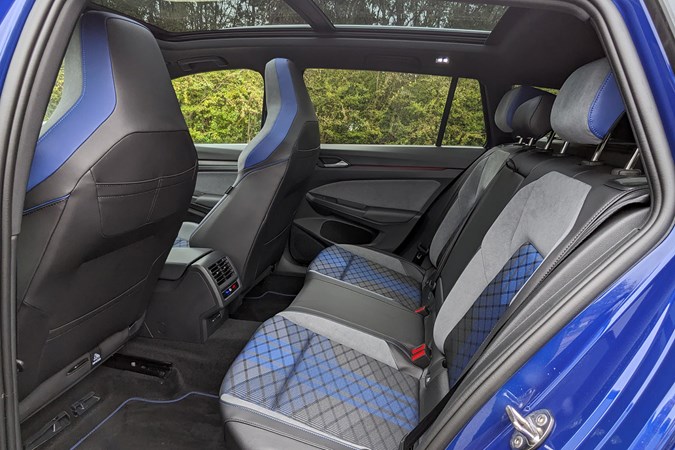
It’s probably not escaped your notice that the Golf R was far more common in Mk7 form than it is the current iteration. You can put that down to the amazing lease deals offered on the older car back in the day, as well as a genuine cult following from enthusiasts.
That does make the older Golf R a bit of a target from boy racers looking to challenge a genuine performance icon from the lights. When I took delivery of my Golf R, I was concerned that I’d be under scrutiny from all manner of chargers – but happily I can confirm that I have been largely left alone, despite this car’s eye-catching paint, large wheels and quad exhaust pipes.
This makes me very happy, because although I like to make decent progress when on a long trip, I really don’t enjoy attracting attention when I do so. And maybe this shows that Volkswagen really knows its customers.

Optional extras: a mixed bunch of upgrades
I touched on the standard equipment of the Golf R spec in my first update, but the optional extras make for interesting reading. Here’s what’s been added:
- Dynamic Chassis Control: £875
Worth it… Variable suspension settings with choice of modes, allows fine-tuning of the dampers with 15 different settings. I’ve started playing with these and they really do work.
- 19-inch Adelaide alloy wheels: £820
Not worth it… They’re the same size as standard and in my experience, diamond cut wheels end up being a maintenance nightmare.
- Rear-view camera: £330
Worth it… Because I find this such a useful thing to have. But I also can’t believe this isn’t standard.
- Panoramic sunroof: £1,210
Worth it… This really does brighten up the interior – but I really do wish they’d not fitted it with stupid touch-sensitive controls.
- Winter pack: £315
Worth it… You get heated front seats, heated washer jets and low washer fluid light, which are a no-brainer for the money.
Infotainment and tech
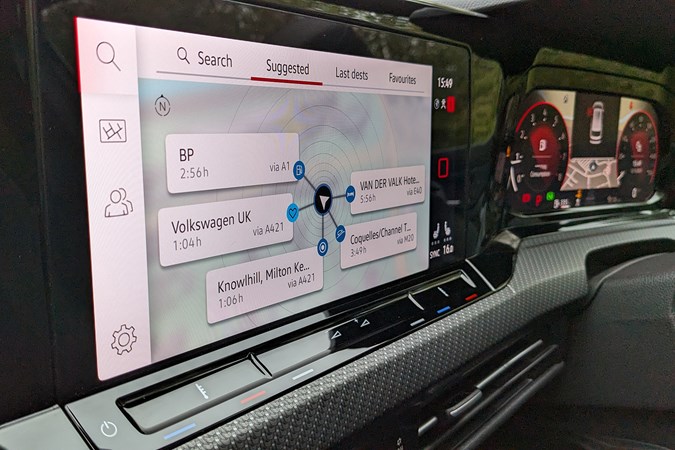
The Golf’s 10.0-inch centre screen is bright and the display looks good, with excellent clarity and a reasonably simple user interface. it’s nicely specified, too, with wireless Android Auto and Apple CarPlay compatability as standard. Using your phone instead of the built-in services is also a cinch, with the car hooking up to either system rapidly and without any issues.
It has built-in sat-nav/DAB/Bluetooth as you’d expect, and all of the (usually) harder-to-find screens such as set-up are one finger tap away from the home screen, so decent marks for Volkswagen there. The car’s instrument display is also digital and delivered by a screen that offers lots of scope for customisation – with all views being clear and offering lots of information.
However, all of that good work is undone by Volkswagen’s baffling decision to sprinkle the cabin with touch sensitive pads to control so many of the car’s functions. They’re simply awful to use, and are a massive retrograde step from the buttons you’d find in older models.
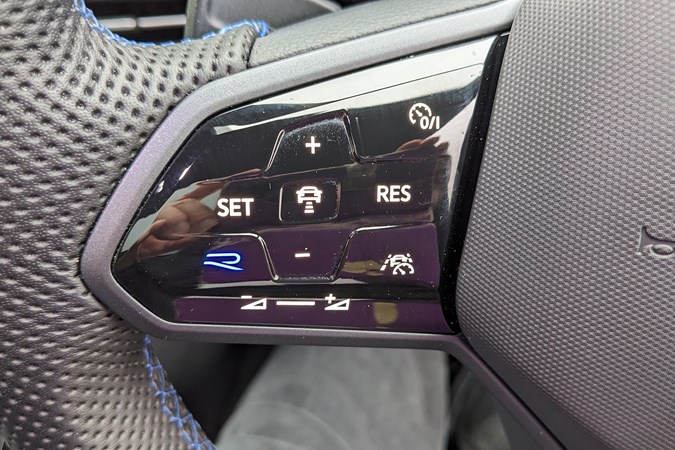
Everything from the headlamp controls (which are are hidden behind the wheel), to the climate controls are touch sensitive, and are an ergonomic nightmare. The worst offenders are the interior temperature and volume adjusters, which is on the natural point you’d rest your hand when operating the touchscreen – guess how that plays out?
The steering wheel controls (above) are equally hateful, offering no discenable feedback. I’ve yet to find a way of making small adjustments to volume, while I’ve lost count of the number of times I’ve put it in Race mode instead of turning on the cruise control.
Before you label me a luddite, I did try and use the voice control system instead – but that’s inactive on our car. Please Volkswagen, ditch the touchpads as quickly as you can.
Update 3: Performance, handling and economy
How quick is it and how well does it drive?
Long story short, it’s quick and handles magnificently, and still does the motorway schlep reasonably well. A light foot will result in good fuel economy too.
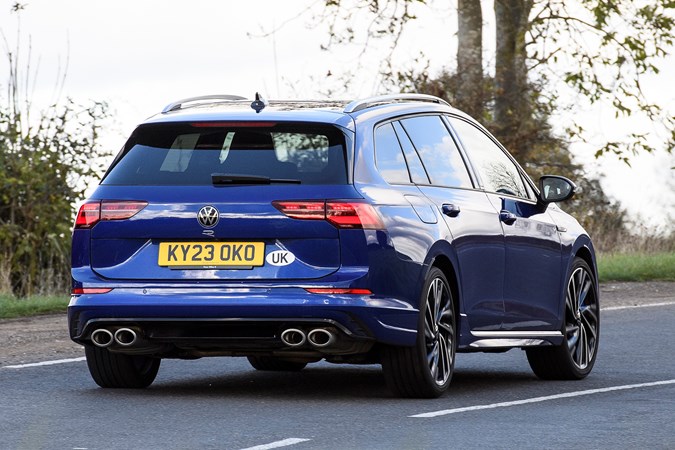
I’ve passed 4,000 miles in the Golf R, and it’s not disappointed in the performance stakes. It’s legendarily quick off the mark, with an official 0-62mph time of 4.9 seconds and a maximum speed of 155mph, and yet it remains docile in town, and comfortable when you’re not in a hurry. We like that.
As you’d expect, it defaults to Sport mode when you fire it up, which kicks in the synthetic sound generator, but otherwise that’s how you’d want it to be, offering grippy handling, and four-wheel drive all-weather confidence.
Where the Golf R really scores is in its ability to get moving quickly, or overtake a dawdler safely on a nice, clear A-Road. Floor it from 40mph, and it’ll be at the national speed limit very quickly indeed, accompanied by a racy engine note.
And the handling?
Just like the Skoda Superb 280 it replaced (below), the Golf R seems to be spending most of its time is spent on the M6 or A1, with a soupcon of B-road running close to home. It’s an interesting comparison and feels surprisingly similar in many ways, most notably in terms of acceleration and economy.
Clearly on the motorway, the Golf is bettered by the lardier Skoda, but it’s far from unrefined, being happily able to cover 500 mile days without breaking a sweat. There is some road and wind noise, and the suspension is firm (even in Comfort mode) but the high speed damping is excellent and seat comfort is good.
But on B-roads, the Golf is in a different league. Get it in Sport or Race mode, and the Golf is a riot. It turns in with precision, the steering firms up nicely, and the handling becomes very playful. And although it’s an estate car with a large boot, it never really feels different to the standard hatch on challenging roads.
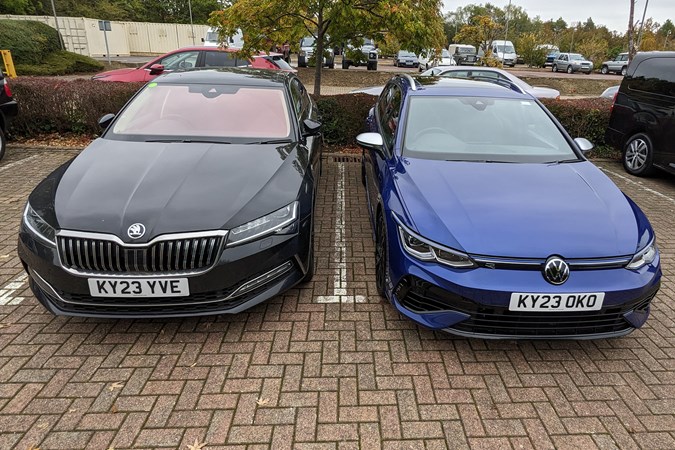
And the fuel consumption?
It’s interesting to note that as the miles build, the Golf R gets better. The engine is loosening up, fuel economy is improving all the time, and the average consumption seems to be hovering around 37mpg – which is amazing for a 320hp petrol-powered estate car.
On my 190-mile commute to the office, mainly dual carriageways and motorways, you can get 40mpg when driven sensibly, giving it an easy 400-mile range. In town that drops to 30mpg, but overall, I’m still ahead of the official figures.
I have a couple of quick-fire European business trips lined up for the Golf, which should be a good test for the Golf R’s long-distance legs. Stay tuned.
Update 4: Comfort
So, 6,000 miles on, how are things going?
Long story short, despite being a sporty family car with more than 300hp, it’s capable and reasonably relaxing on a long European trip, as back-to-back French and Belgian drives proved.
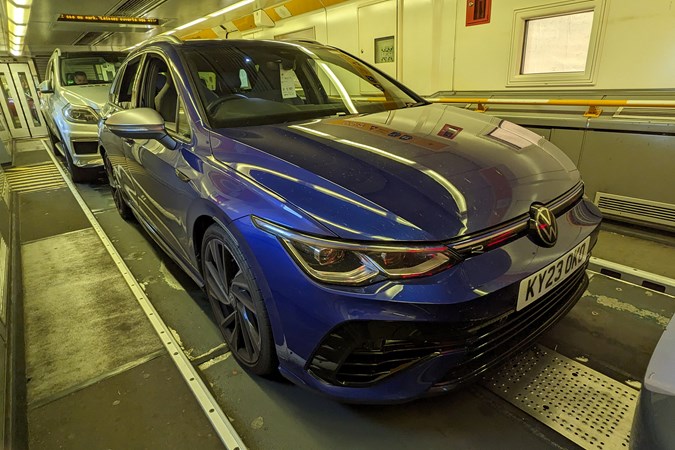
Time flies when you’re having fun. And so, it seems, do miles when you’re driving a car that has a lot going for it. As you’ll have read above, the Golf R’s performance and fuel economy have struck an impressive balance, averaging more than 35mpg, while offering the potential to thoroughly excite on back roads.
This update’s main focus is the car’s comfort, and what better way to test it than take it on a business trip on the other side of the Channel? I found myself in the enviable position of being to eschew the delights of flying for a pair of back-to-back events – one north of Paris, and the other in Brussels. With the Golf R sat on the drive, and the opportunity to cover some serious miles, I’d enjoy this.
And that’s why I found myself on an early start from home to grab a mid-afternoon Eurotunnel crossing. With the tank full, the trip computer tells me the range is 400 miles, which from my gaff in the north of England should get me well into northern France without needing to refuel.

On UK motorways, and with adaptive cruise mode set to 70mph tops, the Golf R averages an easy 40mpg, and the firm seats offer excellent support. Road noise isn’t particularly well contained, and there’s more wind noise than I’d expect, but overall it handles the motorway run to Paris very well indeed.
The adaptive cruise does have an annoying glitch, though, when it can assume you’ve taken the motorway sliproad (when you’ve done no such thing) and can randomly try to brake down to a motorway-friendly speed when you’re still in the fast lane. But you learn to expect the foible, and – let’s face it – it keeps you on your toes.
At more civilised European motorway speeds (80mph) and traffic volumes, fuel consumption increases a little to about 35mpg, but not enough to be concerned about in the context of the car’s performance. Both Paris and Brussels (via my place in the north) were completed without any issues – comfort was fine, and I always managed an easy 350 miles between refuels. Impressive.
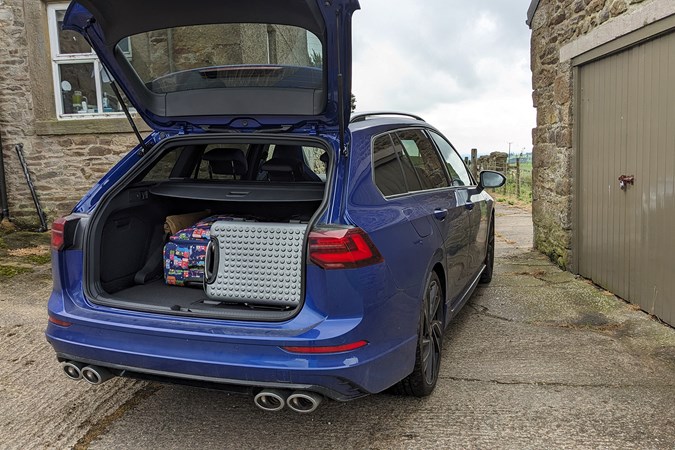
I also managed to get a break after a hectic few weeks, and ended up taking the Golf R away for a few days with my partner and a week’s worth of luggage (that’s a lot of shoes!) as you can see in the picture above.
What impressed me is how commodious the boot is! Just like its Octavia or SEAT Leon Estate sister cars (that have won awards with us in the past), the Golf’s rear end is a real bonus extra that hugely adds to the Golf R’s appeal – especially so, considering its four-wheel drive gubbins under the boot floor.
Sadly, my partner doesn’t get on with the seats’ sporty bolstering and suffered from backache after a long day in the passenger seat. So, I need to keep an eye on that and try and sort a decent seating position for her – but we’ll see. For her, at least, it was a relief to get home again.
Me, I’ll happily forego the plane anytime for another long run in the Golf.
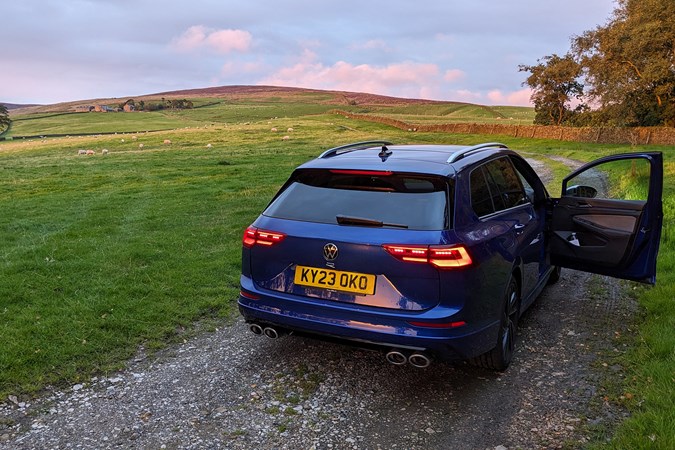
Update 5: Running costs
So, 8,000 miles on, how is the fuel consumption holding up?
Long story short, despite having more than 300hp and having giant-killing performance, the Golf R has the potential for great fuel economy.
Time flies when you’re having fun. And so, it seems, do miles when you’re driving a car that has a lot going for it. As you’ll have read above, the Golf R’s performance and fuel economy have struck an impressive balance, averaging more than 35mpg to this point, while offering the potential to thoroughly excite on back roads.
I’ve given the Golf an easy time, with the majority of its miles being racked up on UK motorways, and within the gloopy traffic flow we have here. Although our average figure pretty much matches the WLTP official average, the more impressive number is what happens on the motorway – take it easy, go with the flow and it’ll nudge 40mpg. I remember when that was good for a diesel family saloon back in the day.

Don’t get me wrong. It’s not always this good. New cars editor, Alan Taylor-Jones, who ran the car briefly on my behalf found it struggled to beat 25mpg on his urban commute, although I suspect he probably enjoyed a fair amount of race mode, too.
As we’re talking about running costs, I should mention the oil consumption. Well, the lack of it, as it hasn’t used a drop so far. In fact, other than fuel the only fluid I’ve needed to top up is the washer fluid (which, annoyingly doesn’t have a low level warning). Bravo Volkswagen, for producing a performance car that you really don’t need to feel guilty about.
Update 6: Interior – on a road trip to Nice and back
Before the Golf R goes back to its maker, we take it on a quick road trip to the South of France…
Long story short, the interior is good, but could be so much better with a set of chunky buttons and less reliance on its touchscreen. C’est la vie.
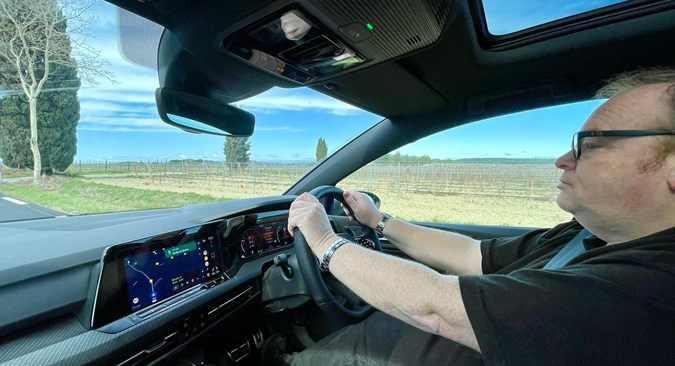
It occurs to me that I’ve yet to speak too much about the interior of the Golf R. Considering its dashboard touch controls are one of the car’s most controversial features, that’s quite a oversight. Blame it on the addictive performance and brilliant handling in Race mode.
What better way to come to a definitive conclusion than to spend four days solid in one while undergoing a business trip in Nice? The idea came about when Volkswagen got in touch offering us a place on the launch of the new Passat – and instead of the grind via Heathrow, I decided to take the Golf R instead. All in the name of thorough testing and to give the car a perfect send-off.
The route down was the usual – the M6/M1/M20 to Folkestone, followed by a quick Eurotunnel dash and southwards via the Autoroute des Anglais, Paris, and on to the Autoroute de la Méridienne until we hit the Mediterranean Sea. It’s a run I’ve done countless times, and a great opportunity to unearth any foibles a car may have.
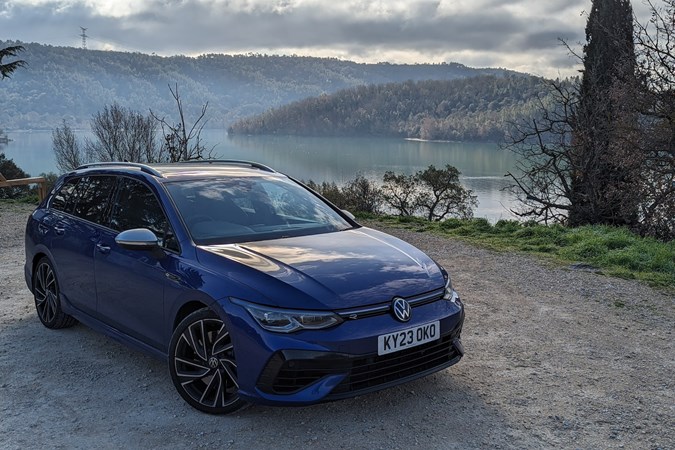
First thing to say is that the Golf covered the 1,200 miles to the southern coast with consummate ease. Although it’s an out-and-out sporting family car, it settles down to a long cruise really well. The seats are comfortable and supportive, there’s plenty of room up-front, the engine and wind noise are not too intrusive, and that glass sunroof lets plenty of light in. Very nice, then.
But there’s a problem. The cruise control is driven using touch sensitive pads on the wheel, and they are a nightmare to use. With no backlighting, these glossy pads have no feedback, and are difficult to navigate. I lose count of the number of times I ended up selecting Race mode rather than Resuming my cruise. Annoying.
The infotainment worked reasonably well, but that’s probably because I used Android Auto instead, and the temperature controls were basically unusable. I should also mention the adaptive cruise control’s automatic speed sign recognition, which often reads the wrong source and slows you down quite aggressively. More than annoying.

But truth be told, you do learn to work around (or live with) these issues, grumbling each time they strike. On the mountainous roads inland of the beaches, the Golf was little short of inspirational, and for that reason alone, it was often easy to laugh off the interior gripes. I do, however, wonder whether I’d feel the same way about a 1.5-litre Match.
As for the journey, I can’t think of many cars that would get you down to Nice in such as unfussed fashion, then entertain so effectively on the amazing Route Napoléon. It really is a special car.
Verdict
Six months in and the verdict is reached. I don’t want to give back the Golf R. The Estate version has such a wide range of abilities and is so well packaged, that it became an indispensible member of the family. For practicality, fun and low-key performance nothing touches it for the money.
Other people love it too. I can’t remember the last time I had a family car that attracted so much positive attention. I’ve had more happy thumbs-ups from other drivers, and petrol station conversations than I care to remember, and they’ve been from a wide variety of people.
Faults? The ergonomics, and lack of steering feel unless you’re going really quickly are about it. There’s a question over the urban fuel consumption, too. But these are minor quibbles in the context of this car’s smörgåsbord of talents.
In short, it’s an instant classic, and in Estate form at least, a car for all people.
Volkswagen Golf R long-term test: scores on the doors
Model tested: R Estate 2.0 TFSI
| Current mileage | 12,525 |
| Real-world average fuel economy | 33.2mpg |
| Official combined fuel economy (WLTP figures) | 35.8mpg |
| Parkers ‘MPP’ (Miles Per Pound) calculation | 5.0-5.3 mpp |
| Car joined Parkers fleet | July 2023 |




